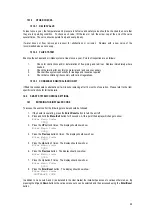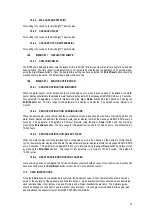
48
7.
Refit the condensate drain and fully recharge by pouring 1 litre of water through the heat exchanger coils.
8.
Reinstall the burner.
9.
Restart the heater as detailed in
Section 13.4.3:
PROCEDURE FOR INITIAL LIGHTING.
15.6
DRAINING WATER HEATER SYSTEM
The water heater must be drained if it is to be shut down and exposed to freezing temperatures. Maintenance and
service procedures may also require draining the water heater.
1.
Turn off the water heater electrical disconnect switch.
2.
Connect a hose to the system drain valve.
3.
Locate hose’s discharge in an area where hot water will not cause any damage or injury.
4.
Close the cold-water inlet valve to water heater system.
5.
Open a nearby hot water outlet to vent the system.
6.
Open the drain valve.
7.
If the water heater is being drained for an extended shutdown, it is suggested the drain valve be left
open during this period.
NOTE: The heat exchanger cannot be completely drained of water without purging with compressed air at a
pressure of 1.0 bar.
15.7
REMOVING SCALE AND SEDIMENT FROM THE STORAGE VESSEL
1.
Drain the water system. Refer to
Section 15.6: DRAINING THE WATER HEATER SYSTEM
.
2.
Remove outer cover plate from the storage vessel casing.
3.
Remove cover and gasket from cleanout opening.
4.
Remove scale or sediment using care not to damage the lining of the vessel.
5.
Inspect cleanout plate gasket and replace if necessary.
6.
Install gasket and cleanout plate. Draw the plate up square by tightening the bolts evenly.
7.
Once the system has been re-filled and a check for leaks carried out, the outer cover plate should be
re-fitted.
15.8
SACRIFICIAL ANODES: INSPECTION AND REPLACEMENT (STORAGE VESSELS)
If the Correx non-sacrificial anode protection system is used, there is no requirement to check the condition
of the anodes.
The tank is protected against corrosion by means of two sacrificial anodes fitted in the front of the storage vessel.
The rate at which the anodes are eroded is dependent on the quality of the water; therefore it is essential that the
anodes are inspected
at least once a year.
1.
Drain the water heater system. Refer to
Section 15.6: DRAINING THE WATER HEATER SYSTEM
.
2.
Remove the outer caps covering the anodes.
3.
Remove each anode and inspect its condition. If the anode has reduced in size by more than 40% or if
the surface is severely pitted, the anode should be replaced.
4.
When refitting the inspected or replaced anode, a suitable jointing compound should be applied to the
threads of the anode to prevent water leakage.
15.9
REFILLING THE SYSTEM
1.
Close the drain valve.
2.
Open a hot water fixture to allow air to escape.
3.
Open the cold water supply to water heater and allow the tank to fill.
4.
Follow the lighting instructions as detailed in
Section 13.4.3:
PROCEDURE FOR INITIAL LIGHTING.
5.
Check for water leakage.





































